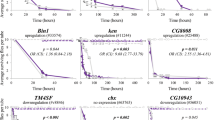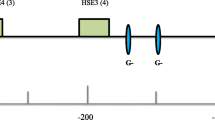Abstract
We compared a series of Drosophila strains with P element insertions from −28 to −144 nucleotides 5′ to the transcription start site of the Hsp70A genes—corresponding to the range of naturally occurring P element insertion sites—to elucidate the consequences of insertion site for Hsp70A gene expression. Although all insertions reduced Hsp70A expression below that of a control strain, the magnitude of the reduction was inversely related to the number of nucleotides between the transcription start site and the insertion site. A pre-existing hypothesis is that naturally occuring transposable element insertions in Hsp promoters may be beneficial in some circumstances, which may account for their retention in natural populations. In the present study, in a control line heat shock reduced fecundity, whereas in lines with P element insertions heat shock typically increased fecundity. Finally, according to cluster-specific quantitative RT-PCR, expression of the Hsp70A cluster genes was typically greater than that of the Hsp70B gene cluster genes, although the latter are more numerous and, in this case, free of P element insertions.






Similar content being viewed by others
References
Amin J, Fernandez M, Ananthan J, Lis JT, Voellmy R (1994) Cooperative binding of heat shock transcription factor to the hsp70 promoter in vivo and in vitro. J Biol Chem 269:4804–4811
Bettencourt BR, Feder ME (2001) Hsp70 duplication in the Drosophila melanogaster species group: how and when did two become five. Mol Biol Evol 18:1272–1282
Bettencourt BR, Kim I, Hoffmann AA, Feder ME (2002) Response to natural and laboratory selection at the Drosophila hsp70 genes. Evolution 56:1796–1801
Boehm AK, Saunders A, Werner J, Lis JT (2003) Transcription factor and polymerase recruitment, modification, and movement on dhsp70 in vivo in the minutes following heat shock. Mol Cell Biol 23:7628–7637
Cartwright IL, Elgin SCR (1986) Nucleosomal instability and induction of new upstream protein-dna associations accompany activation of 4 small heat-shock protein genes in Drosophila melanogaster. Mol Cell Biol 6:779–791
Evgen'ev MB, Zatsepina OG, Garbuz D, Lerman DN, Velikodvorskaya V, Zelentsova E, Feder ME (2004) Evolution and arrangement of the hsp70 gene cluster in two closely related species of the virilis group of Drosophila. Chromosoma 11:3223–232
Feder ME, Cartaño NV, Milos L, Krebs RA, Lindquist SL (1996) Effect of engineering hsp70 copy number on Hsp70 expression and tolerance of ecologically relevant heat shock in larvae and pupae of Drosophila melanogaster. J Exp Biol 199:1837–1844
Feder ME, Krebs RA (1997) Ecological and evolutionary physiology of heat-shock proteins and the stress response in Drosophila: complementary insights from genetic engineering and natural variation. In: Bijlsma R, Loeschcke VS (eds) Stress, adaptation, and evolution. Birkhäuser Verlag, Basel, pp 155–173
Gong WJ, Golic KG (2006) Loss of hsp70 in Drosophila is pleiotropic, with effects on thermotolerance, recovery from heat shock and neurodegeneration. Genetics 172:275–286
Hochstrasser M (1987) Chromosome structure in four wild-type polytene tissues of Drosophila melanogaster: The 87A and 87C heat shock loci are induced unequally in the midgut in a manner dependent on growth temperature. Chromosoma 95:197–208
Kazazian HH (2004) Mobile elements: drivers of genome evolution. Science 303:1626–1632
Krebs RA, Feder ME (1997) Deleterious consequences of Hsp70 overexpression in Drosophila melanogaster larvae. Cell Stress Chaperones 2:60–71
Krebs RA, Feder ME (1998) Hsp70 and larval thermotolerance in Drosophila melanogaster: how much is enough and when is more too much. J Insect Physiol 44:1091–1101
Lakhotia SC, Prasanth KV (2002) Tissue- and development-specific induction and turnover of hsp70 transcripts from loci 87A and 87C after heat shock and during recovery in Drosophila melanogaster. J Exp Biol 205:345–358
Lerman DN, Feder ME (2005) Naturally occurring transposable elements disrupt hsp70 promoter function in Drosophila melanogaster. Mol Biol Evol 22:776–783
Lerman DN, Michalak P, Helin AB, Bettencourt BR, Feder ME (2003) Modification of heat-shock gene expression in Drosophila melanogaster populations via transposable elements. Mol Biol Evol 20:135–144
Lindquist S (1993) Autoregulation of the heat-shock response. In: Ilan JT (ed) Translational regulation of gene expression 2, Vol. 2. Plenum Press, New York, pp 279–320
Lu Q, Wallrath LL, Granok H, Elgin SCR (1993) (CT)n.(GA)n repeats and heat-shock elements have distinct roles in chromatin structure and transcriptional activation of the Drosophila Hsp26 gene. Mol Cell Biol 13:2802–2814
Maside X, Bartolome C, Charlesworth B (2002) S-element insertions are associated with the evolution of the hsp70 genes in Drosophila melanogaster. Curr Biol 12:1686–1691
Michalak P, Minkov I, Helin A, Lerman DN, Bettencourt BR, Feder ME, Korol AB, Nevo E (2001) Genetic evidence for adaptation-driven incipient speciation of Drosophila melanogaster along a microclimatic contrast in “Evolution Canyon,” Israel. Proc Natl Acad Sci U S A 98:13195–13200
Quivy JP, Becker PB (1996) The architecture of the heat-inducible Drosophila hsp27 promoter in nuclei. J Mol Biol 256:249–263
Shilova VY, Garbuz DG, Myasyankina EN, Chen B, Evgen’ev MB, Feder ME, Zatsepina OG (2006) Remarkable site specificity of local transposition into the Hsp70 promoter of Drosophila melanogaster. Genetics 173:809–820
Silbermann R, Tatar M (2000) Reproductive costs of heat shock protein in transgenic Drosophila melanogaster Evolution 54:2038–2045
Solomon JM, Rossi JM, Golic K, McGarry T, Lindquist S (1991) Changes in Hsp70 alter thermotolerance and heat-shock regulation in Drosophila New Biologist 3:1106–1120
Thomas GH, Elgin SC (1988) Protein/DNA architecture of the DNase I hypersensitive region of the Drosophila hsp26 promoter. EMBO J 72:191–201
Timakov B, Liu X, Turgut I, Zhang P (2002) Timing and targeting of P-element local transposition in the male germline cells of Drosophila melanogaster. Genetics 160:1011–1022
Velazquez JM, Sonoda S, Bugaisky G, Lindquist S (1983) Is the major Drosophila heat shock protein present in cells that have not been heat shocked. J Cell Biol 96:286–290
Volff JN, 2006 Turning junk into gold: domestication of transposable elements and the creation of new genes in eukaryotes. Bioessays 28:913–922
Walser JC, Chen B, Feder ME (2006) Heat-shock promoters: Targets for evolution by P transposable elements in Drosophila. PLoS Genetics 2:1541–1555
Wang Z, Lindquist S (1998) Developmentally regulated nuclear transport of transcription factors in Drosophila embryos enable the heat shock response. Development 125:4841–4850
Weber JA, Taxman DJ, Lu Q, Gilmour DS (1997) Molecular architecture of the hsp70 promoter after deletion of the TATA box or the upstream regulation region. Mol Cell Biol 173:799–808
Welte MA, Tetrault JM, Dellavalle RP, Lindquist SL (1993) A new method for manipulating transgenes: engineering heat tolerance in a complex, multicellular organism. Curr Biol 3:842–853
Yao J, Munson KM, Webb WW, Lis JT (2006) Dynamics of heat shock factor association with native gene loci in living cells. Nature 442:1050–1053
Acknowledgement
The work was supported by Russian Academy Grant for Molecular and Cellular Biology to M.B.E., Russian Grants for Basic Science 06-04-48993-a and 06-04-48854-a, and National Science Foundation grant IBN03-16627. Bing Chen was supported by the China Scholarship Council.
Author information
Authors and Affiliations
Corresponding author
Rights and permissions
About this article
Cite this article
Chen, B., Shilova, V.Y., Zatsepina, O.G. et al. Location of P element insertions in the proximal promoter region of Hsp70A is consequential for gene expression and correlated with fecundity in Drosophila melanogaster . Cell Stress and Chaperones 13, 11–17 (2008). https://doi.org/10.1007/s12192-007-0002-4
Received:
Revised:
Accepted:
Published:
Issue Date:
DOI: https://doi.org/10.1007/s12192-007-0002-4




